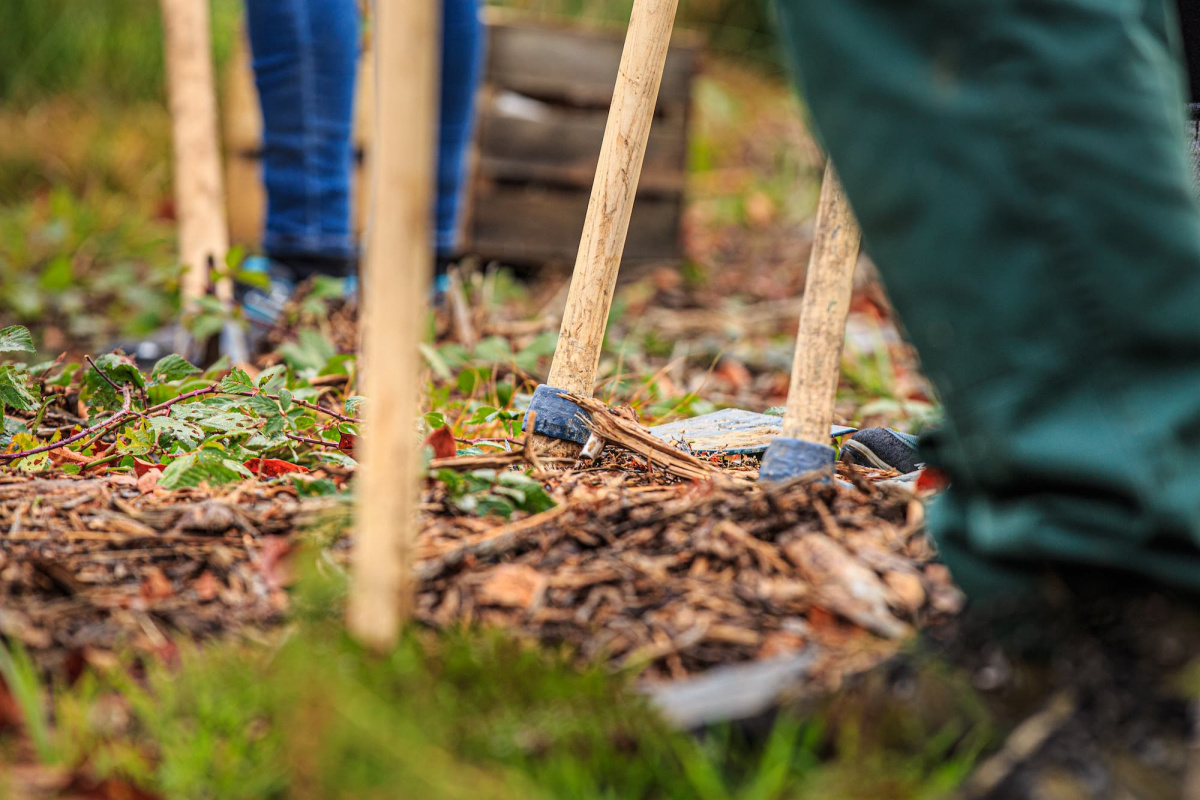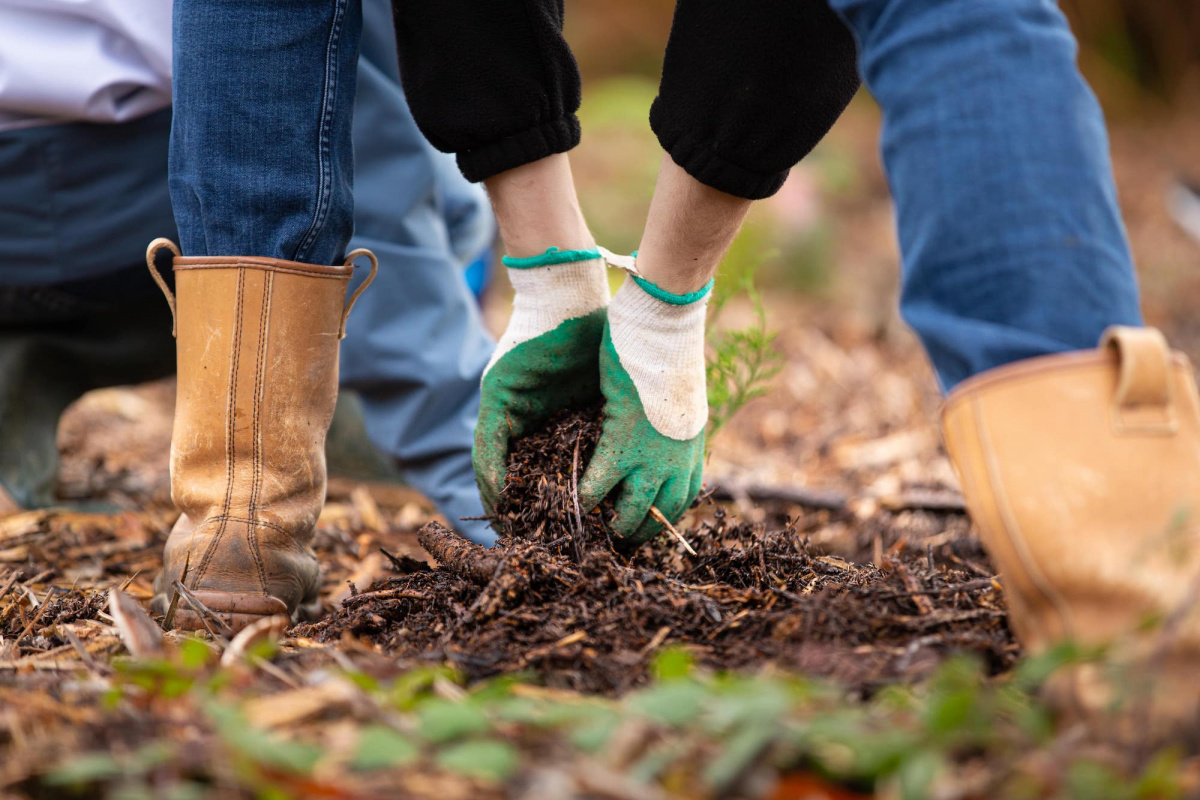10/03/2022 - Ondine de Reforest'Action
Preparing the hole and planting the shrub
Ideal conditions for planting a tree
Where on the plot should you plant your tree?
The location of the tree should be chosen according to its spread and final size. To provide a sunny space for the tree to grow, it is advisable to locate the tree at a distance of 2 or more metres from any building. Concrete terraces, pipes and water tables should all be avoided, as they may be damaged.
When is the ideal planting period?
Deciduous species are planted between November and March. During this period, there is little sunlight (less than 10 hours of daylight a day) and the plants are at rest. While plant growth is on hold, the sap descends into the roots to help the plant take root and build up the resources needed for spring. The right planting time will also depend on the species’ tolerance to frost, flooding and drought.
Which species should we plant?
Nurseries produce a wide variety of fruit, forest and ornamental trees for replanting. Specialists are on hand there to advise on the suitability of the species according to plot size, soil type, climate and the desired characteristics. Some species are known to grow faster, such as lime, weeping willow or silver maple, but slower-growing fruit or flowering trees will also bring many other benefits.
Within the same group of species, native, threatened or rare species are ideal for enhancing the existing ecosystem. In this case, planting black pine, cork oak, or broad-leaved whitebeam can be an act of conservation and assisted migration1. A stand of mixed species will be healthier, and resilient species should be preferred as a way of coping with climate change.
While oaks and some conifers seem to deal better with heat, drought remains a major problem.
In addition, certain Mediterranean species will acclimatise better in more northerly areas or at higher altitudes. Genetically diverse plants will also increase the stand’s resistance to pests, diseases and extreme weather conditions.
How to plant a tree?
Preparing the hole
The young tree should be planted to the same depth as it was in the nursery. The hole should be dug to a depth of 50–60 cm and be three times the size of the root ball. To optimise soil drainage, the sides of the hole can be “broken up” using a pickaxe. Finally, a stake can be placed in the hole before introducing the plant, to support the growing tree.
Planting the tree
Place the tree in the hole, taking care to ensure that the root ball remains below the surface. The soil added back into the hole can be loosened with potting soil, compost and organic fertiliser. Sand can also be added to improve soil drainage.
Laying mulch
Mulch is made up of organic matter (wood shavings, straw, grass) and keeps competing vegetation down while preventing soil crusting after heavy rain. For two or three years, it will maintain suitable agronomic and climatic conditions for tree growth and ensure cool, moist soil.
Protecting the trees
Many different factors threaten the growth of newly planted trees. To counter this, protective sleeves, tubes or fences can be installed to protect the tree from predators.

Preparing the soil before planting
Is planting a tree a good idea?
The benefits of planting a tree
Trees are powerful contributors to air purification and they harbour biodiversity. They protect crops from natural disturbances and provide islands of coolness. Planting a tree is therefore a way of investing in the future of your land and the ecosystem that thrives there. The impact of tree planting is significant on several counts.
-
Ecosystems: Tree planting also helps protect existing ecosystems. Trees help to protect the surrounding area from natural disturbances such as wind, floods or landslides. Once fallen, their leaves provide rich organic matter for soil fertility, crucial for the proper functioning of the forest ecosystem.
-
Carbon emissions: Due to their role as carbon sinks, trees store CO2 in the wood and soil, thereby helping to reduce greenhouse gas emissions. Managed sustainably, trees are vital to the energy transition and fossil fuel reduction.
-
Biodiversity: Trees provide a refuge for biodiversity and also foster the natural development of its ecosystem. The common oak in particular plays a major role in harbouring fauna and flora, standing out from other native species because of this high hosting potential. Once planted, this species is home to a wide range of insects (more than 400 species of butterfly, 100 species of beetle, a dozen flies and wasps), birds, mammals, lichens and fungi.
The limits to tree planting
Not all species are equal, and planting a tree can be counterproductive if the choice of site, species or forest management applied in the future forest stand are poorly adapted.
Some species are less resistant than others to drought or biotic hazards. An example of this is the Monchique forest stand in Portugal, where eucalyptus has played havoc with the environment and local communities. This highly flammable invasive species was introduced en masse in the 1950s to combat soil erosion and now covers a quarter of the country, but has significantly increased the fire risk. In artificial forests, planting non-native species can also deplete the ecosystem and endanger water supplies.
It is also worth questioning the usefulness of tree planting in the case of very large-scale projects. If applied on an excessive scale or as part of a monoculture system, tree planting can stray from the original aim of protecting and restoring existing natural ecosystems.
For example, in 2010 Ethiopia launched a large-scale planting programme called the Green Legacy Initiative, with 350 million trees to be planted on a single day2.
These massive tree planting campaigns do not always achieve the hoped-for results: due to poor management, 75% of the seeds sown or trees planted failed to grow3.
Planting can therefore sometimes have limits. It is certainly true that trees help to capture carbon and thus combat global warming, but the approach can also have harmful consequences if poorly implemented. For trees to play a meaningful role in CO2 capture, they need to be planted in the right place, at the right time, managed in an appropriate and sustainable manner, and allowed to develop over a long life cycle.
Sources :


0 Comment